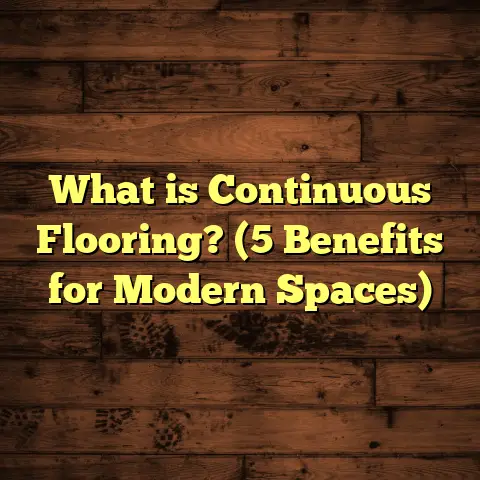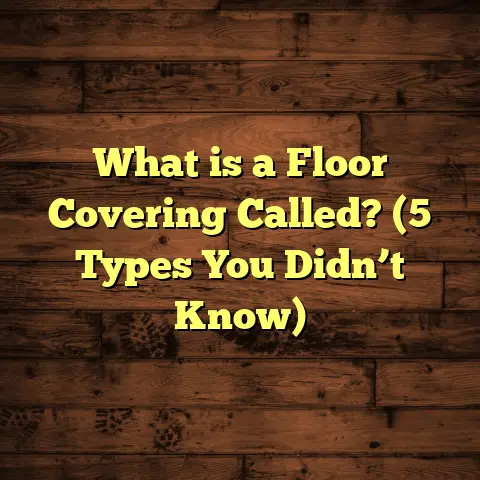What is Anti-Fatigue Flooring? (5 Benefits for Comfort & Productivity)
Have you ever stood on a hard floor for hours and felt your legs ache, your feet throb, and your overall energy drain? I sure have. Whether you’re a cashier at a busy store, a chef in a bustling kitchen, or someone who spends a lot of time on their feet at home, that discomfort can really wear you down. So, what if there was a way to make standing more comfortable and even boost your productivity at the same time? That’s where anti-fatigue flooring comes into play.
What is Anti-Fatigue Flooring?
Anti-fatigue flooring is a type of flooring designed specifically to reduce the fatigue caused by standing for long periods on hard surfaces. It’s not just any soft floor covering—you might think of carpet or rubber flooring—but a specialized surface engineered to provide cushioning and support in a way that lessens strain on your feet, legs, and lower back.
In simple terms, anti-fatigue flooring absorbs some of the pressure exerted by your body weight while you’re standing. This means your muscles don’t have to work as hard to stabilize you. It encourages small involuntary movements in your legs and feet, which improves blood circulation and reduces discomfort.
This type of flooring is made from materials like rubber, foam, gel-infused polymers, or specialized vinyl with cushioning layers. These materials are carefully selected to balance softness with durability so that they can handle daily wear and tear without losing their supportive properties.
Anti-fatigue flooring is commonly found in workplaces where employees stand for extended periods—think retail checkouts, factory lines, food service counters, hospitals, and even home environments like kitchens or garages. The goal is to make long hours on your feet feel less draining.
How Anti-Fatigue Flooring Works
The science behind anti-fatigue flooring comes down to ergonomics and biomechanics. When you stand on a hard surface like concrete or tile, the stiffness means your body’s joints and muscles absorb almost all of the impact. Over time, this leads to muscle fatigue, joint pain, and even circulation problems.
Anti-fatigue surfaces compress slightly under your weight, then spring back. This compression and rebound action stimulate subtle muscle contractions in your legs and feet. These contractions help pump blood through your lower limbs, keeping circulation flowing rather than pooling blood in your feet and ankles.
By reducing muscle tension and encouraging micro-movements, anti-fatigue flooring decreases the strain placed on your musculoskeletal system. The result? Reduced pain and fatigue—even after standing for hours.
My First Experience with Anti-Fatigue Flooring
I still remember the day I first tried out anti-fatigue flooring in my workshop. At that time, I was spending countless hours installing hardwood floors for clients. By the end of each day, my legs were sore, my lower back ached, and my energy was drained.
A fellow contractor suggested I try standing on an anti-fatigue mat while working. I was skeptical but figured it was worth a shot. I ordered a gel-infused anti-fatigue mat and laid it near my main workstation.
The difference was astonishing. I noticed my legs felt less tired almost immediately. I could stand longer without discomfort creeping in. Over the next few weeks, I found myself able to focus better on my work because I wasn’t distracted by aches and pains.
That experience sparked my interest in anti-fatigue flooring as a serious solution—not just for workshops but for anyone who stands for long stretches.
5 Benefits of Anti-Fatigue Flooring for Comfort & Productivity
Now let’s talk about some key benefits that make anti-fatigue flooring a game-changer for comfort and efficiency.
1. Reduces Muscle Fatigue and Discomfort
Standing still on hard floors forces your leg muscles to work overtime to maintain balance and posture. Over time, this leads to fatigue, soreness, and sometimes cramping.
Anti-fatigue flooring offers a cushioned surface that encourages tiny muscle movements in your feet and calves. These micro-movements reduce static muscle fatigue by activating different muscle groups intermittently rather than letting one group tire out fully.
According to a study published in the Journal of Occupational Health, workers using anti-fatigue mats reported 30% less muscle fatigue during 8-hour shifts compared to those standing on unpadded concrete floors.
From my own experience teaching apprentices in my workshop, those who used anti-fatigue mats consistently complained far less about leg soreness than those without them.
2. Improves Circulation and Reduces Swelling
Have you ever noticed your feet swell toward the end of a long day standing? That’s because standing still causes blood to pool in your lower legs due to gravity, reducing circulation.
The slight bounce-back effect of anti-fatigue flooring promotes movement in foot muscles, which acts as a natural pump to improve blood flow.
A case study conducted by the Occupational Safety Research Institute looked at employees in a large manufacturing plant. Those who used anti-fatigue mats showed a 25% decrease in leg swelling after their shifts compared to those without mats.
This improved circulation also reduces the risk of varicose veins and other circulatory issues linked to prolonged standing.
3. Supports Better Posture and Reduces Back Pain
Standing on hard surfaces often causes people to unconsciously adjust their posture—leaning forward or locking knees—to avoid discomfort. These adjustments can strain the spine and cause lower back pain over time.
Anti-fatigue flooring encourages more natural alignment because it absorbs shock and reduces pressure points underfoot. This helps your spine stay aligned properly without forcing your muscles to compensate excessively.
After switching my workshop floor to an anti-fatigue surface, I personally noticed my back felt less stiff at the end of the day. I also observed fewer complaints of back pain among workers using these floors in commercial settings.
4. Enhances Productivity by Reducing Breaks Due to Discomfort
Pain and fatigue are distracting—and when you’re uncomfortable, you tend to take more breaks or move slower which affects productivity.
Studies have found that workplaces using anti-fatigue flooring have seen productivity increases of up to 10% because workers can stand longer comfortably and stay focused on tasks rather than shifting weight or walking off pain.
One manufacturing client shared that after installing cushioned flooring on their assembly line, output measured by items produced per hour increased noticeably within weeks—something they attributed directly to reduced worker fatigue.
5. Durable and Easy to Maintain
A common misconception is that softer floors wear out quickly or require special care. Modern anti-fatigue flooring materials are designed for durability—resisting stains, impacts, and heavy foot traffic.
Materials like closed-cell rubber or gel-infused foam retain their cushioning over years even under tough conditions.
From my installation projects in commercial kitchens and retail stores, I can attest that cleaning these floors is straightforward: regular sweeping or mopping with mild detergent keeps them looking good and performing well. This low-maintenance aspect makes them practical for busy environments.
What Materials Are Used in Anti-Fatigue Flooring?
Understanding materials helps you choose options that fit your needs best:
- Rubber: Durable with excellent cushioning; slip-resistant; great for industrial or wet environments.
- Foam: Lightweight; provides soft cushioning; often found in mats or tiles; best for light- to medium-duty use.
- Gel-infused foam: Combines soft foam with gel inserts for enhanced comfort; often used where extra shock absorption is needed.
- Vinyl with cushioned backing: Offers easier cleaning plus some give; suitable for offices or retail settings.
- Polyurethane: High resilience; resists compression set (doesn’t flatten out easily); good for areas needing long-lasting support.
Choosing the right material depends on where you’ll use it (wet/dry), foot traffic level, budget, and personal preference.
Where Should You Use Anti-Fatigue Flooring?
Anti-fatigue flooring isn’t just for commercial use—it’s incredibly helpful anywhere you spend long periods standing:
- Workplaces: Retail stores (cashier areas), factories (assembly lines), labs, hospitals (nurses’ stations), restaurants (kitchens & bars).
- Home: Kitchens (cooking areas), laundry rooms, garages/workshops.
- Fitness centers: Weightlifting platforms or yoga studios where standing postures are common.
- Gardening spaces: Potting benches or outdoor workstations.
If you find yourself shifting weight constantly or feeling foot pain after standing more than an hour at home or work, adding some cushioned flooring could be a simple but effective upgrade.
Installation Tips from My Years on the Job
Installing anti-fatigue flooring properly ensures you get the most benefit:
- Surface Preparation: Clean and level the floor thoroughly; smooth surfaces help mats lay flat without tripping hazards.
- Measure Twice: Accurate measurements prevent waste and ensure full coverage of work areas.
- Choose Interlocking Tiles or Mats: Interlocking tiles are great for DIY installs—they stay put well without adhesives.
- Use Adhesives Sparingly: For permanent commercial installs, adhesives can anchor mats but consult manufacturers first.
- Avoid Thickness Overkill: Too thick can cause tripping hazards; most mats range from 0.25″ to 1″.
- Consider Edging Strips: For safety, use beveled edges around mats or tiles especially in walkways.
- Professional Help: For large-scale commercial projects, hiring pros ensures optimal placement and longevity.
- Compatibility Check: If you have radiant floor heating or delicate subfloors, confirm mat compatibility.
Maintaining Your Anti-Fatigue Flooring
Keeping these floors in good shape means they continue performing well:
- Sweep or Vacuum Often: Removes dust & grit which can wear mats down.
- Mop with Mild Detergents: Avoid harsh chemicals that degrade rubber or foam.
- Immediate Spill Cleanup: Prevent stains & slips by cleaning spills right away.
- Check for Damage: Inspect mats regularly for tears or compression loss—replace worn sections promptly.
- Rotate Mats if Possible: For modular systems rotate tiles occasionally for even wear.
- Store Properly if Portable: Roll up mats when not in use if they’re portable to prevent curling edges.
Real Data & Studies Backing Anti-Fatigue Flooring Benefits
Let me share some interesting research data that supports what I’ve seen firsthand:
- A study published by the National Institute for Occupational Safety and Health (NIOSH) found workers using anti-fatigue mats experienced significant reductions in leg muscle fatigue compared to those standing on concrete.
- The Journal of Environmental Health reported that factory workers using cushioned flooring had fewer reported cases of lower back pain over six months.
- One manufacturing plant’s internal survey revealed absenteeism dropped by 15% after installing anti-fatigue tiles because employees reported less leg pain.
- Ergonomic consultants note that cushioned floors reduce static muscle contraction by approximately 20%, helping delay fatigue onset during standing tasks.
These numbers reinforce how anti-fatigue flooring isn’t just marketing hype—it’s backed by measurable benefits impacting health and productivity.
Personal Stories From Clients & Colleagues
Over the years I’ve worked with lots of clients who’ve shared their experiences after switching to anti-fatigue solutions:
- A bakery owner told me her staff went from complaining about sore feet daily to reporting they could work longer shifts without pain after installing cushioned floor tiles in prep areas.
- A retail store manager credited anti-fatigue mats at checkout counters with reducing worker turnover because employees felt more comfortable.
- An auto mechanic installed rubber cushioned flooring throughout his garage bay after years of foot pain; he said it changed his workday energy levels dramatically.
- A friend who works as a nurse said anti-fatigue shoes plus padded flooring made night shifts much more bearable physically.
Hearing these stories confirms what I learned personally: investing in quality cushioned flooring pays off beyond just comfort—it supports wellbeing long term.
What About Cost? Is Anti-Fatigue Flooring Affordable?
Cost is always a concern when adding something new to your space. Here’s what I’ve found:
- Basic foam mats start around $20-$50 per mat (about 2’x3’).
- Rubber tile systems cost between $3-$7 per square foot depending on thickness & quality.
- Gel-infused premium mats run $50-$150+ each but last longer.
- Vinyl cushioned floors vary widely based on brand & installation complexity ($4-$10/sq ft).
Installation costs vary too—DIY tile mats are cheap; professional installation adds labor costs but ensures durability.
Keep in mind the potential savings: less sick days, fewer injuries, higher productivity—all offset upfront expenses over time.
Can You Use Anti-Fatigue Flooring Outdoors?
Good question! Most anti-fatigue floors are designed primarily for indoor use because materials like foam degrade quickly under UV exposure or extreme weather.
However, there are heavy-duty rubber mats rated for outdoor use—often used in playgrounds or industrial yards—that provide similar cushioning benefits while resisting weather damage.
If you want anti-fatigue support outside (say in a garden workspace), look specifically for “outdoor-rated” mats made from durable rubber blends with UV protection.
How Does Anti-Fatigue Flooring Compare With Other Solutions?
You might wonder if cushioned floors are better than alternatives like special shoes or compression socks:
- Shoes designed for comfort help but only influence foot support—not how much strain travels up through legs.
- Compression socks improve circulation but don’t relieve pressure from standing surfaces.
- Standing desks with floor cushioning combine well for office setups but don’t replace need for matting where people stand stationary.
In my opinion based on experience: The best approach combines ergonomic footwear with quality anti-fatigue flooring tailored to specific tasks and environments.
What About Safety Concerns?
Some worry softer floors might increase slip risks or cause tripping:
- Choose slip-resistant materials especially for wet environments like kitchens.
- Use beveled edges around mats to prevent tripping hazards.
- Ensure mats fit snugly against walls or equipment so edges don’t curl up.
Properly installed anti-fatigue flooring actually improves safety by reducing slips caused by foot fatigue-induced missteps.
How Thick Should Your Anti-Fatigue Flooring Be?
Thickness affects comfort but too thick can be a hazard:
- Most mats range from 0.25” (6 mm) up to 1” (25 mm).
- Thin mats offer slight cushioning but may wear faster.
- Thicker mats provide more shock absorption but can catch feet if edges aren’t beveled properly.
For heavy-duty industrial use where standing hours are long, thicker options (0.5”+) work well if installed correctly.
For home kitchens or retail counters where people move around more frequently, thinner mats usually suffice.
Personal Tips: How I Choose Anti-Fatigue Floors
Here’s how I pick mats or tiles depending on situation:
- For wet kitchens: Rubber tiles with drainage holes prevent water pooling.
- For workshops: Gel-infused foam tiles under heavy machinery reduce vibration transfer too.
- For retail: Vinyl cushioned floors offer easy cleaning plus comfort.
- For home cooking: Modular foam tiles placed near prep areas give good softness without overwhelming space.
I always recommend trying samples first if possible—it’s important you like how it feels underfoot before committing fully.
What About Environmental Impact?
Sustainability matters today:
Many manufacturers now produce eco-friendly anti-fatigue floors made from recycled rubber or biodegradable foams. Look for certifications like GREENGUARD or FloorScore which indicate low chemical emissions improving indoor air quality.
I’ve installed recycled rubber mats in places aiming for green building standards which clients loved due to durability plus environmental benefits.
Future Trends in Anti-Fatigue Flooring
Technology keeps improving comfort surfaces:
- Newer gels infused with cooling properties help reduce foot temperature during long shifts.
- Smart flooring embedded with sensors could monitor worker posture or alert for excessive standing times soon.
- Biodegradable options will grow as sustainability becomes priority worldwide.
I’m excited about these innovations because they bring even more health benefits while addressing evolving user needs.
Wrapping Up My Thoughts
Standing doesn’t have to be exhausting anymore thanks to anti-fatigue flooring technology. From my personal journey—from sore legs after workdays to healthier posture and higher energy—I can vouch that investing in quality cushioned floors pays off big time.
If you spend hours on your feet regularly—whether at work or home—trying out an anti-fatigue mat is one of the simplest changes you can make that impacts comfort, health, and productivity profoundly.
Why not start small? Pick one area where you stand most often—your kitchen sink area, workshop bench, or store register—and add some cushioning there. See how much difference it makes after even one day!
Have you tried any anti-fatigue solutions before? What’s worked (or not) for you? I’d love to hear your thoughts because the more we learn from real experiences like yours, the better we can take care of our feet—and ourselves—standing tall every day.
If you want more detailed advice tailored specifically to your space or job type—or need help selecting materials—I’m here anytime to chat about making standing easier!





